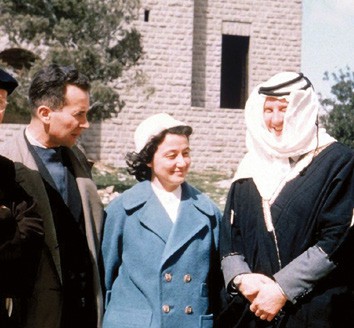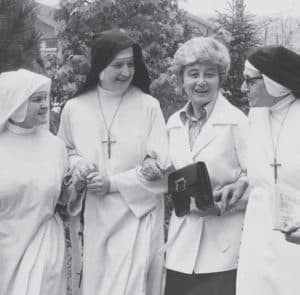As throughout history, the Holy Spirit has always responded to the needs of the Church when there have been major crises in the world. The response is in the form of a “charism,” a gift given to an individual or a group to carry out a specific action that transmits an aspect of God’s love in the service of his people. Chapter 12 of the First Letter of Paul to the Corinthians enumerates a number of charisms given to the early Church during its foundational years.
But over the centuries, the concept of “charism” had not been widely used until Vatican II when it was brought back into focus especially by Cardinal Joseph Suenens. He invited everyone to recognize that in every part of the world there have been lay people clearly endowed with gifts of the Holy Spirit expressed through the ministries they had been called to perform.
“Do we not know and see in our daily experience that the action of the Holy Spirit has not died out in the Church? Charisms still exist in the Church… Recognition of this fact,” he emphasized, “is important for any well-balanced view of the Church. Such charisms are not mere peripheral phenomena or accidental appendages to the Church, but part of its nature.”
Twenty years earlier, in 1943 in the midst of the destruction of World War II, Trent had become a place where the Holy Spirit responded to the distress of the time and used Chiara Lubich as an instrument to bring about healing by entrusting her with the charism of unity.
Unlocking the charism
Chiara understood that a charism is not a onetime-only gift that remains static. It is the gift of a dynamic relationship with the Holy Spirit that invites and impels new expressions constantly responding to the needs of the world and the Church. Chiara experienced that this dynamism is unlocked and activated through a radical living of the Word of God, particularly by putting into practice the New Commandment, “Love one another as I have loved you” (Jn 13:34).
She and her friends experienced that it was mutual love that generated communion and created community. The first people who lived this lifestyle became examples of how the power of the charism of unity is unleashed only when it is put into action by loving one another to the point of being prepared to lay down one’s life for one another.
A passion for the Church
Living out the charism of unity affected also the relationship with the People of God, the Church, as Chiara expressed it: “I feel that with the gift of the Ideal [of unity] that God is continually giving to us — with his constant gifts of heavenly wisdom — God is maturing in us a love for the Church which borders on, or perhaps is, a ‘passion’ for the Church…

The Church is made up of human beings, so there is a human part as well, but there is also a supernatural part, which is the Holy Spirit in the Church…. I would explain it like this: passion is such a great love that it moves you towards an object, towards something in such a forceful way that all the rest falls into oblivion; you don’t see anything else.”
Pertinent today is how Chiara describes the sentiments we are asked to have for the Church: “You may ask me: how? God wants us to feel in ourselves all the joys of the Church. They are ours, the joys of the Church are us. The sufferings of the Church are ours! He wants the radiant face of holiness that is spread everywhere in the Church to be our face! He wants us to feel that it is ours! He wants us to consider our own the Church’s face disfigured by all the errors that are present in the Church, to take as our own the cry of anguish in the heart of the Church…
“Thus, the Church cries out for them: ‘My God, why have you forsaken me?’ God did not send this spirituality for the Focolare Movement, but for the Church, and wherever there is no unity, we have to bring it. When there is not unity, it is Jesus Forsaken, we are that Jesus forsaken who is waiting for this spirituality of unity.”
Constantly new expressions
A charism can be likened to ripples spreading from a source. The ripples of mutual love within the Church were lived and expressed by Chiara and the first women who were struck by this new way of putting their Christian faith into practice. Soon, however, the circles started to expand to involve other people: men, religious, couples, youth, priests and so it continues.
The gift of the charism is to awaken in others an awareness of the meaning of their vocations, as lived expressions of the Gospel. Eventually, practically every vocation in the Church was able to find a deeper expression of its call through the charism of unity and its particular Gospel light.
From its origin within the Roman Catholic Church, ripples of the charism have found expression in the other Christian Churches as well as followers of many other religious groups. The dynamic work of the Holy Spirit through the charism of unity can even be seen in multiple expressions in the world outside of a religious context, in the spheres of economics, politics, art, education, to name just a few.
How to recognize other charisms Personally, as a religious, a member of the Missionary Oblates of Mary Immaculate, Chiara’s charism has taught me many things about my vocation to consecrated life in the Church. Firstly, I experienced Chiara as a living foundress, and was able to understand that all the founding figures throughout the history of the Church have the same characteristics.
All experience an aspect of God with a particular awareness. All find an expression of this awareness in a particular text that sums up the whole of Scripture for them, and which they incarnate and live in their community life and mission.

Chiara has helped all men and women religious to recognize, and rediscover in a new light, the charism given by the Holy Spirit to our own foundresses and founders. We can recognize the same dynamism in Sts. Francis, Teresa, Eugène de Mazenod, Frances Xavier Cabrini, to mention a few.
The principles which Chiara and her followers lived by are the very ones that have unlocked the mission of each institute of consecrated life over the centuries. She gave an impulse to newer ecclesial charisms to engage with the much older charisms in a process of rediscovery and redefining, since a charism never stops finding new expressions.
Today, Chiara’s spirituality of unity is helping the various charism families to work together for the good of the whole Church.
People in different states of life often find meaning and a source of new life in a particular charism and live that charism according to their situation and circumstances. This provides a model for how lay people also participate in the charism, originally given to a religious congregation or order.
I, together with thousands of others, am grateful to Chiara for having taught me to understand what a charism really is, how it is a dynamic relationship with God, with one another, and with the creation. She taught me to rediscover the charism of my own founder and how to make it accessible to people in all walks of life.
Thanks to her example, I have understood the role and mission of our various charism’s families throughout the world: we exist to work towards the same goal of unity, which is the fullness of the kingdom of God here on earth.




